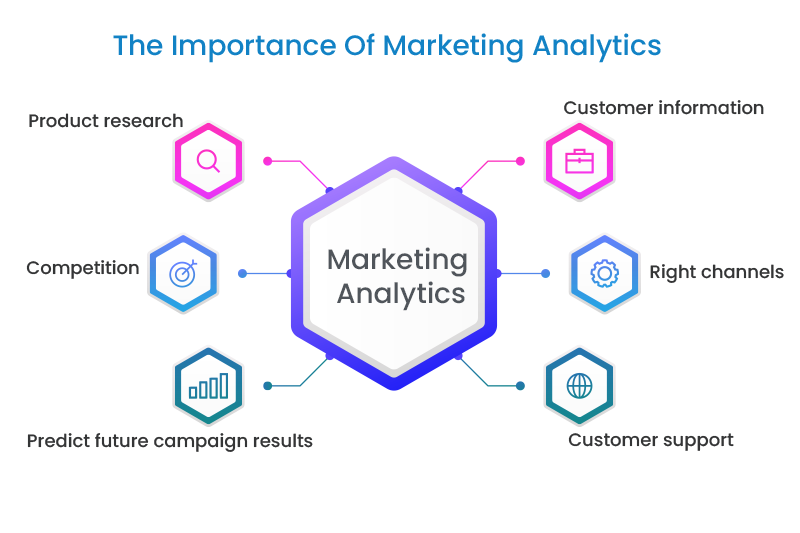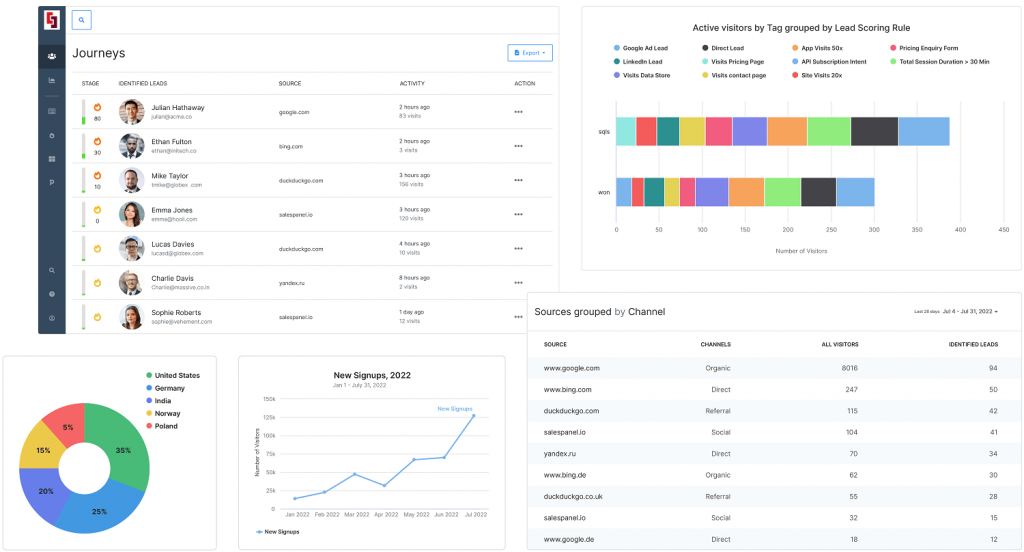Importance of Marketing Analytics in 2023
Reading Time: 7 minutes
Analytics has become a key factor for businesses looking to make informed decisions, improve their performance, and keep up with the competition. Marketers often face challenges like reaching the right audience, getting the most out of their marketing budget, and adapting to changing customer needs. This is where marketing analytics comes in, offering a way to tackle these obstacles effectively.
In this blog post, we’ll discuss the importance of marketing analytics for businesses and how it helps marketers overcome common challenges. We’ll look at the benefits, such as better targeting, personalization, and data-driven decision-making.
What is Marketing Analytics?
Marketing analytics is the process of gathering, measuring, analyzing, and interpreting data from a variety of marketing channels to uncover valuable insights into customer behavior, preferences, and trends. This data-driven approach empowers businesses to make informed decisions and craft strategies that connect with their target audience, ultimately leading to improved results and a higher return on investment (ROI).
Marketing analytics covers a diverse array of data sources, such as website analytics, social media metrics, email marketing performance, and even traditional offline marketing efforts. By employing mathematical techniques, predictive modeling, and machine learning, marketing analytics unlocks a deeper understanding of consumer behavior and preferences, enabling businesses to optimize their product or service positioning for increased sales.
Role of Data in Marketing Analytics
Data has become increasingly important in shaping effective marketing strategies. Harnessing data allows marketers to gain a deep understanding of their target audience, identify customer needs, and design strategies to deliver goods and services that address those needs.
Using data, marketers can:
- Personalize the customer experience by creating tailored content and offers.
- Target well-defined marketing segments, focusing on the most relevant customer groups.
- Acquire new customers by crafting appealing marketing campaigns.
Moreover, data enables businesses to measure and improve their marketing strategies in real-time, refining their efforts to maximize results. By leveraging data, businesses can successfully navigate the complexities of today’s marketing landscape and achieve greater success.

Why is Marketing Analytics Important?
Marketing analytics plays a vital role in helping businesses make informed decisions, optimize their marketing efforts, and ultimately achieve success. Let’s look at how marketing analytics can be helpful for your business.
Develop Data-Informed Marketing Strategies
One of the primary advantages of marketing analytics is that it enables businesses to develop data-informed marketing strategies. By analyzing customer behavior, preferences, and trends, businesses can create targeted and personalized marketing campaigns that resonate with their audience. This data-driven approach ensures that marketing efforts are based on solid evidence rather than intuition or anecdotal evidence, leading to more effective and successful marketing campaigns.
Eliminate Guesswork or Over-Reliance on Anecdotal Evidence
Marketing analytics removes the guesswork from the marketing process, allowing businesses to make decisions based on concrete data and evidence. By analyzing the performance of various marketing efforts and campaigns, businesses can identify which strategies are most effective and allocate resources accordingly. This data-driven approach ensures that businesses are not wasting valuable time, effort, and resources on marketing strategies that may not yield desired results.
Make Informed Business Decisions
Marketing analytics provides businesses with the necessary insights to make informed decisions about their marketing efforts. By understanding which marketing channels and tactics are most effective, businesses can allocate their marketing budget more efficiently and focus on strategies that are more likely to yield a high return on investment (ROI).
Improve Customer Relationship Management
Marketing analytics helps businesses improve their customer relationship management (CRM) by providing insights into customer behavior and preferences. By understanding customer needs and preferences, businesses can tailor their marketing efforts to better meet customer expectations, build stronger relationships, and foster brand loyalty.
Understand the ROI of Different Campaigns and Efforts
One of the most crucial aspects of marketing analytics is its ability to measure the ROI of various marketing efforts and campaigns. By analyzing the performance of different marketing channels and tactics, businesses can determine which strategies are most effective and allocate resources accordingly. This insight enables businesses to maximize their marketing budget and ensure that their efforts are yielding the desired results.
Determine Campaign Success and Adjustments
Marketing analytics allows businesses to evaluate the success of their marketing campaigns and determine whether they should be repeated, adjusted, or discontinued. This insight enables businesses to continuously refine their marketing efforts, leading to more successful marketing campaigns and better overall results.
Enhance Customer Experience
By leveraging marketing analytics insights, businesses can better understand their customers and create marketing strategies that cater to their unique needs and preferences. This tailored approach leads to a better overall customer experience, as businesses can deliver personalized content and offers that resonate with their target audience.
Price Optimization
Marketing analytics can help businesses optimize their pricing strategies by providing insights into customer price sensitivity, demand, and competitive pricing. By understanding these factors, businesses can set prices that maximize profitability while still offering value to customers.
Robust Lead Nurturing and Management
Effective lead nurturing and management are essential for driving sales and growing a business. Marketing analytics provides businesses with the necessary data to understand where leads are in the sales funnel, allowing them to create targeted marketing campaigns to nurture and convert leads into customers. By understanding customer behavior and preferences, businesses can better engage with leads and move them through the sales funnel more efficiently.

Key Components of Marketing Analytics
Let’s discuss the four main components of marketing analytics: data collection and integration, data analysis and visualization, predictive modeling and forecasting, and performance measurement and reporting.
1. Data Collection and Integration
The first step in marketing analytics is collecting and integrating data from various sources, such as websites, social media platforms, CRM systems, and offline marketing efforts. This data enables businesses to develop a comprehensive understanding of their target audience, their behavior, preferences, and purchasing patterns. Data collection and integration are crucial for creating a unified view of customer data that can be used to inform marketing strategies and drive business growth.
To successfully collect and integrate data, businesses must:
- Identify the relevant data sources and metrics that align with their marketing objectives.
- Implement reliable data collection methods to ensure data accuracy and completeness.
- Use data integration tools or platforms to consolidate data from various sources, providing a unified view of customer data.
2. Data Analysis and Visualization
Once the data is collected and integrated, the next step is data analysis and visualization. Data analysis involves examining the data to identify patterns, trends, and insights that can inform marketing strategies. Data visualization tools, such as dashboards and charts, help businesses present their data in a visually appealing and easily digestible format, enabling them to quickly identify key insights and make informed decisions.
To effectively analyze and visualize data, businesses should:
- Leverage advanced data analytics tools and techniques to uncover hidden patterns and trends in the data.
- Use data visualization tools to present data in an easily understandable format, facilitating better decision-making.
- Regularly review and update their data analysis and visualization efforts to ensure they remain relevant and accurate.
3. Predictive Modeling and Forecasting
Predictive modeling and forecasting are essential components of marketing analytics that help businesses anticipate future trends, customer needs, and marketing outcomes. By leveraging historical data, machine learning algorithms, and statistical techniques, predictive modeling and forecasting enable businesses to make data-driven predictions about the future, allowing them to better plan and optimize their marketing efforts.
To implement predictive modeling and forecasting, businesses should:
- Invest in predictive analytics tools and technologies that can analyze historical data and identify trends.
- Collaborate with data scientists and analysts to develop accurate and reliable predictive models.
- Continuously refine and update their predictive models to ensure they remain relevant and accurate.
4. Performance Measurement and Reporting
The final component is performance measurement and reporting. This process involves tracking and evaluating the effectiveness of marketing efforts and campaigns, measuring their success against predetermined goals and KPIs. Performance measurement and reporting enable businesses to identify which strategies are working, which need improvement, and how to allocate resources most effectively.
To successfully measure and report on marketing performance, businesses should:
- Establish clear goals and KPIs that align with their overall marketing objectives.
- Implement a robust performance tracking and reporting system to monitor the success of their marketing efforts.
- Regularly review and analyze their performance data to identify areas for improvement and adjust their marketing strategies accordingly.

Salespanel for B2B Marketing Analytics
Salespanel is a customer journey tracking and B2B analytics solution designed to help businesses effectively analyze first-party data from their websites and connect it with their customers. Unlike traditional analytics, Salespanel offers valuable insights into customer behavior and buyer intent, making it ideal for B2B companies looking to track entire customer journeys, get analytical insights, score leads, automate workflows, and personalize their marketing efforts for better sales results. Sales teams can leverage this analytical data and lead scores to understand customer behavior and intent more accurately.
Salespanel only collects first-party data, provides GDPR-compliant tracking, and requires user consent before tracking can begin. It avoids the issues faced by other analytics platforms by not using data at rest for other purposes and not relying on third-party cookies. Plus, we help with server-side implementation to Enterprises, preparing them for the future of cookie-less tracking.

Conclusion
Marketing analytics has become an indispensable tool for businesses aiming to make informed decisions, improve their performance, and outpace competitors. By leveraging marketing analytics, companies can overcome common challenges and capitalize on opportunities such as better targeting, personalization, and data-driven decision-making. This article explored the importance of marketing analytics, its key components, and how Salespanel’s B2B analytics solution can provide valuable insights into customer behavior and buyer intent. By adopting marketing analytics, businesses can stay ahead in today’s fast-paced, ever-changing marketing landscape and achieve greater success.
Sell more, understand your customers’ journey for free!
Sales and Marketing teams spend millions of dollars to bring visitors to your website. But do you track your customer’s journey? Do you know who buys and why?
Around 8% of your website traffic will sign up on your lead forms. What happens to the other 92% of your traffic? Can you identify your visiting accounts? Can you engage and retarget your qualified visitors even if they are not identified?
